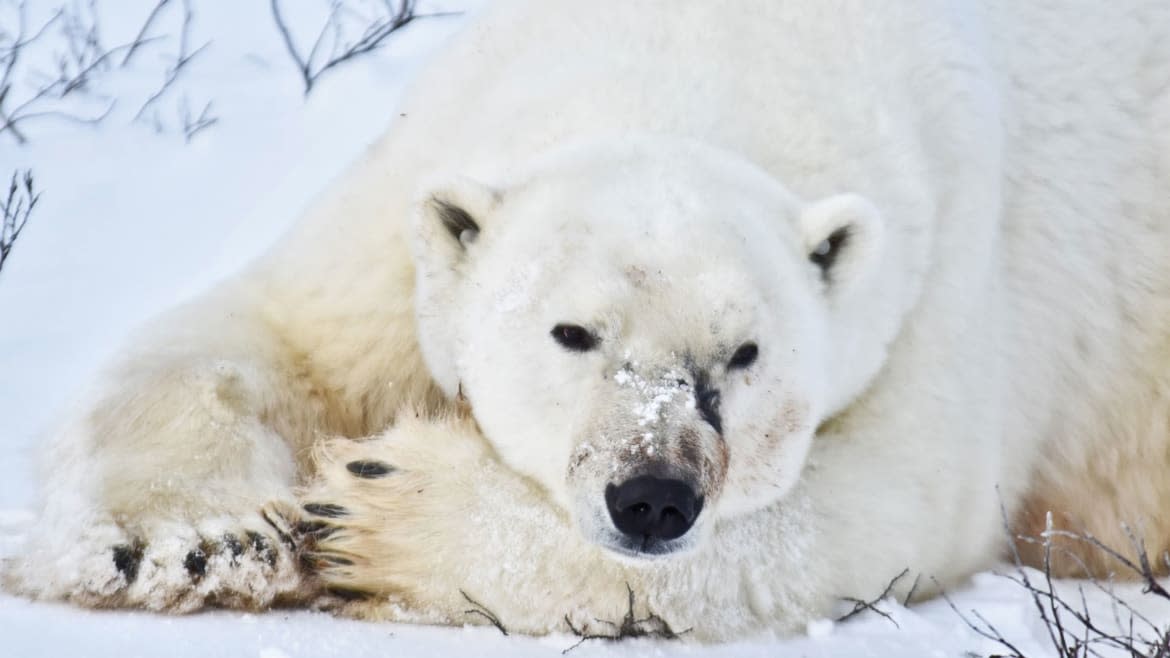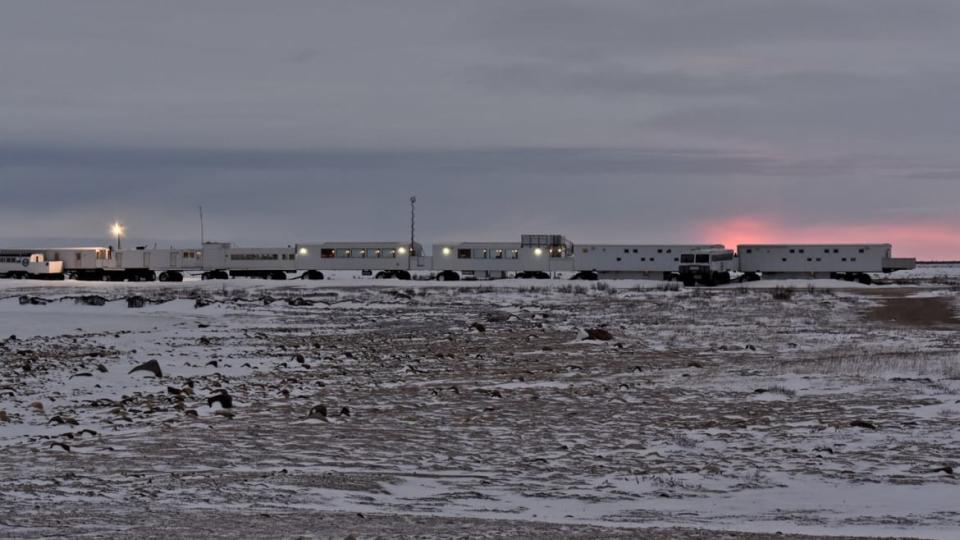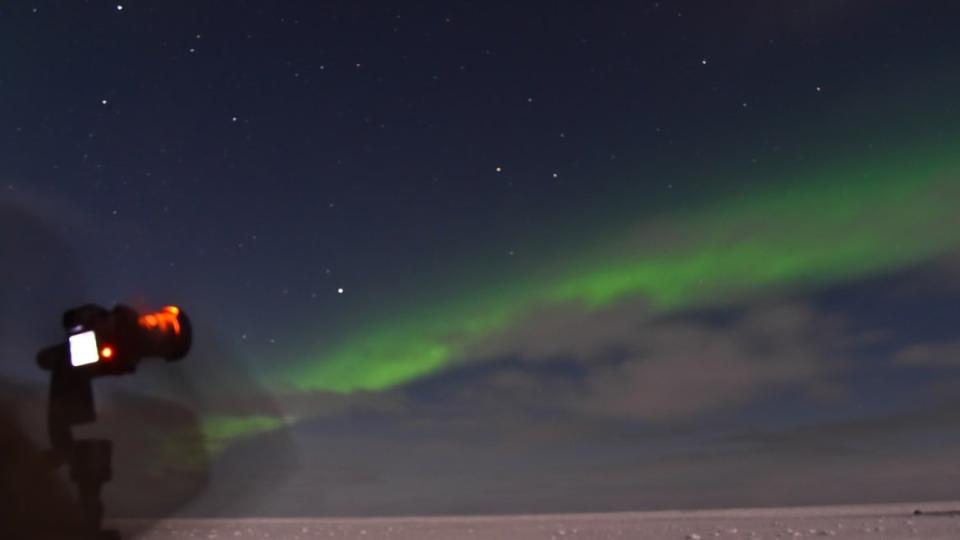Climate Change Will Make Polar Bear Tourism More Unpredictable

It’s 5 a.m. and 20 bunk beds, separated by a walkway and individual curtains, are quiet—mostly. Snoring waxes and wanes, almost to the rhythm of the room, rocked by 20 mph winds. But it’s a comfortable respite from the cold. I check my phone: 0 degrees Fahrenheit, feels like -23.
I’m in Churchill, Manitoba, at the invitation of Travel Manitoba and Frontiers North Adventures to see polar bears. Polar bears, the northern lights, and beluga whales are at the heart of tourism in northern Canada. Visitors travel from all over the globe to see these threatened white giants before climate change takes them. It also raises a question: In a world being reshaped by climate change, what does the future of tourism based on polar bears look like?
I break the syncopated snoring when I open a door to go get coffee. It requires passing between sleeping units into the blustery Canadian subarctic over safe, but frosty, steel viewing platforms. Dense cold air climbs up my sleeves as I pause outside, looking left and right.
“No polar bears. Maybe next time,” I think.
This is the Tundra Buggy Lodge, a series of connected units and Tundra Buggies hunkered down in the wind-beaten snowscape of Manitoba’s polar bear country. Polar bears drive tourism here.

"Frontiers North’s The Tundra Buggy Lodge in the subarctic tundra"
Shortly after my arrival, for example, I was introduced to accomplished musher, Dave Daley, a native of the Métis people and founder of a 220-mile race, known as the Hudson Bay Quest. His Wapusk Adventures flies the flag of the Métis people—an infinite loop across a blue sky. While I’m in town, I’m going to do a short dogsledding track through the boreal forest, which he calls the “Ididamile.”
Daley is a charismatic personality, which is only amplified by his coyote hat and contagious enthusiasm for his canine family. He jokes that he only does the Ididamile with tours so he can afford to feed his dogs. While the snow may not disappear anytime soon, a Churchill without polar bears is a loss of draw to the region and will mean a decline in other forms of tourism, like dogsledding.
Fortunately, polar bears are still around Churchill.
At breakfast in the dining car at the Tundra Buggy Lodge on the first day of our polar bear retreat, guests talk about their favorite vacations, what cameras and lenses they own, and how they can’t wait to see polar bears. Afterwards, we grab snacks from a table, our gear and coats, and head out to Tundra Buggy 16, docked at the end of our sleeper unit.
Tundra Buggies are Frontiers North’s mammoth vehicles—white and rectangular with massive tires—that look as if they could be equally at home on the moon as they are on the tundra. They are spacious inside with two rows of seats on each side of an aisle, a bathroom (of sorts), and a door leading out to an observation platform, which is generally high enough for a polar bear to stand on its hind legs and be just out of reach of guests.
The tourists on this Buggy are here in part because it is (for many) a once-in-a-lifetime chance to see the polar bear in the wild.
“It was that Paul Nicklen photo on Instagram of the emaciated, dead polar bear carcass—that for me was like a shake, like someone shook you and was like ‘pay attention: this is really happening’,” says Nassim Sanani, a marriage and family therapist from Los Angeles. “They won’t be here much longer,” she adds, “these special creatures won’t be here.”
Tourists are not the only people here to see the wildlife.
As I talk to the lodge staff and guides—seasonal workers—I also find those who are here because they are drawn to the uniqueness of working in Churchill and the chance to see the animals that live here.
Polar bears mean jobs in tourism for them.
One of our guides, Mike Gere, leads photography tours in Jasper, Alberta, at other times of year. His experience taking photos of wildlife and the northern lights makes for a great polar bear guide with Frontiers North’s photography tours and for winter work.
He’s not alone.
“It gives you the freedom, flexibility, and the time to do what you love,” lodge staff member Samantha Gerrit tells me. “I’m an artist. I’m a painter. It’s not a very stable lifestyle, so the only way to do it is through lodge work, because it gives me a roof over my head, it gives me food, it gives me a really cool experience here in the tundra.”
On Tundra Buggy 16, tourists have planned, and for many, saved money to have this opportunity. This tour is designed for photographers, all hoping to get those memorable photos of bears like Nicklen’s. With some irony then, day one is mostly a Buggy of photographers playing a game of “polar bear or a rock?” It turns out that most of us can’t yet tell the difference between them from a distance.
Day 1 on the Tundra Buggy 16: Arctic Hare? Check. Ptarmigan? Check. Rocks? Definitely, check. No polar bears.
There is a catch-22 for polar bear-loving tourists: If bears aren’t on land, that means there is some ice on the bay where they can hunt seals. That’s a good thing for the bear, but not so much for the paying tourist. But more than that, the difficulty is that there are fewer polar bears to see.
Canada has one of the planet’s largest populations of polar bears, making the region a focus of scientists, like those at Polar Bears International (PBI), based in Churchill.
Polar Bears are less adaptable than grizzlies, Geoff York, senior director of conservation for Polar Bears International tells me. “They need not just meat,” he adds, they also must have “marine mammal fat [seals] to live in this environment successfully; they’re pretty limited on any other calories of that type.”
This is also affecting their ability to reproduce.
“Skinnier females have smaller and fewer cubs,” Thea Bechschoft, a staff scientist for PBI, tells me. “We’re already seeing that the period on land is increasing.”
Polar bears mate in the spring and the egg is fertilized then, but it doesn’t implant until they are done fasting. Longer periods without ice mean longer periods of fasting, with the bear losing approximately 2.2 pounds a day. “She’s not going to be fat enough for her body to send the right signals for the egg to implant,” says Bechshoft, ‘and for her to be able to make the milk to sustain her cubs.”
“Tomorrow, we’ll see polar bears,” is a common refrain I hear, despite not seeing polar bears on our first day. Hope is a powerful siren’s call.
We head back in the evening to have wine in the lounge, hear speakers from PBI, and have dinner. For being as remote as they are, the Tundra Buggy Lodge offers a fantastic three-course gourmet menu through Dan’s Diner, their on-site restaurant. We go back to our bunks and collapse.
The next morning, a guest jokes that she wished upon an eyelash to see a polar bear.
Day 2 on Tundra Buggy 16: Bears—far in the distance—like dust mites traveling across the ice.
“Well, that eyelash really phoned it in,” I think.
We return for our wine again, another presentation, and a chance to tour the PBI research vehicle, Tundra Buggy One. PBI works with Frontiers North to research bears. It’s a mutual relationship that manages to also gives me the rare access to Wi-Fi in the middle of nowhere. It also means that tourism itself is helping to fund conservation research.
Our no-bear-fatigue is now a consensus.
To cheer us up, a PBI researcher tells us that it is warming up outside, the ice is breaking up fast, and that she really hopes that we would see bears the next day.
There goes that hope, again.
But then, as if on cue and in mid-sentence, she looks out the window and shouts “bear!” The oxygen in the Buggy is sucked out by our collective gasp as a lone polar bear with a large scar across his nose—dubbed Scarface, for obvious reasons—curiously checks out the smells he’s picked up near the kitchen.
About time, eyelash.
The faces in the room instantly slide from exhaustion to elation. I watch as a woman near me is in tears—literal tears of joy. She turns to another guest near her she doesn’t really know and gives her an excited hug. But almost as quickly as he arrives, the bear vanishes into the dark. Our untempered giddiness echoed and spooked him. It is enough to reinvigorate the virality of hope.
Day 2 on Tundra Buggy 16: Edit. One bear. Close up. Briefly.
The next morning, no one walks to breakfast or dinner, or anywhere for that matter, without cameras slung around their necks. “The price of a bear photo is eternal vigilance,” to paraphrase a famous aphorism.
The next day, we set out on Tundra Buggy 16 again and see Scarface hanging out nearby the lodge, apparently in no hurry to run away this time. He’s looking for food. He rises, lunges upwards on his back legs, and slams his paws down on the frozen ground. He shoves his claws into the now broken ground and digs out frozen kelp. It’s mostly useless calories and, according to PBI, like humans, polar bears eat when they’re bored.
Within little time, another Tundra Buggy shows up with another group also on our tour, as well as the rovers of Frontiers North’s competitors, Great White Bear Tours.
We all huddle around Scarface in our buggies—camera shutters in rapid fire—as he sniffs out our vehicles, walks underneath our viewing platforms just a few feet away, scratches his ass using willow branches, and then sleeps. (I imagine him dreaming of seal blubber.)
As mundane as it may sound, it is an amazing feeling to have a wild polar bear within feet of your camera, to have him stop below you, to notice him looking at you directly in the eye, to wonder if he’s deciding if you have enough blubber to make it worth his while.
By noon, Scarface—who saved us from bearlessness—disappeared into the distance on the ice.
Day 3 on Tundra Buggy 16: One bear. The same bear. A bear, nonetheless. Also, late that night: the aurora borealis.

"Arctic Fox looking for food"
Days 4 and 5: Arctic fox. Ptarmigan. No bears. We pack up and head to the airport to begin our treks home.
Why is it that other tours encountered bears, but ours did not? What does this mean for polar bear tourism?
As I’m the only journalist with this group, some guests decide to tell me about their disappointment in only seeing one polar bear. They also insist on caveats: they love the staff; they love the food; they love the tundra. Still, they wonder if Frontiers North could have, and should have, predicted fewer bears or cancelled.
It’s a fair question.
“We understand no one books a trip with the intent for it to be cancelled, and that is our same approach to trip planning,” says Frontiers North’s manager and head of marketing and communications, Jessica Burtnick. “We love hosting guests at Cape Churchill and in the CWMA [Churchill Wildlife and Management Area]. More importantly, though, is that we love to delight our guests.”
Burtnick tells me they survey and monitor bear populations and “traditionally” this is a good time of the year for bear volumes. “Variations in weather conditions and bear presence occur year-to-year,” she adds, “so it doesn’t suffice to single out an anomalous autumn and consider that part of an overall ‘trend’.”
“The two weeks prior to your trip had higher bear numbers and activity,” confirms Geoff York, “so there is definitely a timing and luck component, as is true of any wildlife viewing around the world.”
But things are changing, he notes. Churchill no longer has an open garbage dump and photographers no longer put out attractants, so bears are now less likely to congregate in town.
There are also not as many bears as in previous decades.
“Despite the current best management practices,” York tells me, they have “seen a 30 percent decline in almost 30 years. The adjacent, southern Hudson Bay population is down 17-18 percent.” Bear density is also lower, he adds, pointing to some studies. He insists, however, that with 800 bears in the immediate area, the chances of seeing them is still “excellent.”
In other words, climate change means warmer temps and less ice. Less ice means bears lose an important food source, and that leads to fewer and smaller bears overall. And to add to the problem: these warmer temps (and human expansion) are starting to push grizzlies into polar bear territory, leading to more potential competition for resources. This shuffling around is not a problem restricted to the Canadian Arctic; Russian towns have also recently seen unpredictable changes in polar bear behavior due to ice loss, leading the animals en masse to invade towns in search of food.
With Arctic warming accelerating and a new study showing that—while the growth of greenhouse gas emissions slowed—2019 will still record another increase, a lot of work still needs to be done.

"The Aurora Borealis"
“It’s not that the changes coming will make Churchill less interesting in the near term—the next 20 years,” says York, “but it will make it different. It’s becoming, he says “a little more wild and less predictable.”
That unpredictability may mean the next several years will operate as usual, but it can also mean that tourism will have to adapt. One of those adjustments: Frontiers North cancelled their 10 Days in the Cape tour, which was to follow ours. The reason: below-normal temperatures means more ice and the polar bears leaving to satisfy that seal craving.
Waiting for my flight home, I consider coming back earlier in the year when the bears are on land. A man at my gate asks what brought me to northern Canada.
I tell him about the dogsledding, the wonderful frozen tundra, and the unexpectedly good food. I also pull up photos on my phone like a proud parent and tell him about Scarface—the lone polar bear who gave us the time of day before heading off onto the ice to find seal blubber.
Get our top stories in your inbox every day. Sign up now!
Daily Beast Membership: Beast Inside goes deeper on the stories that matter to you. Learn more.

